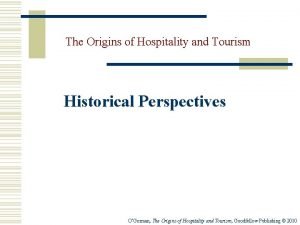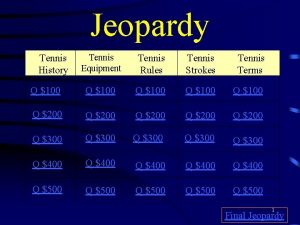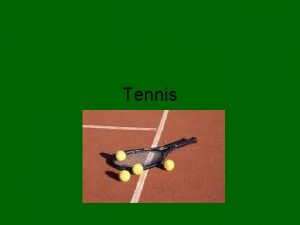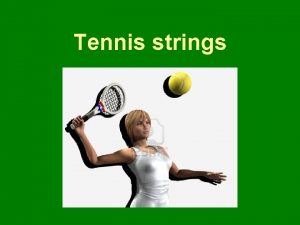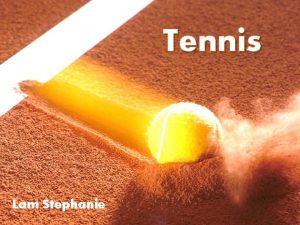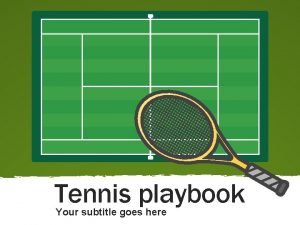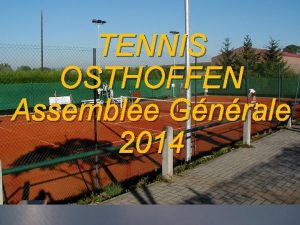The Origins and Early History of Tennis n

















































- Slides: 49



















The Origins and Early History of Tennis n n The earliest origins of tennis are a matter of some dispute. One side believes that the ancient Egyptians, Greeks, and Romans played a precursor to tennis. Drawings or descriptions of any tennis-like games have not been discovered, but a few Arabic words dating from ancient Egyptian times are cited as evidence. The theory says that the name tennis derives from the Egyptian town of Tinnis alongside the Nile and the word racquet evolved from the Arabic word for palm of the hand, rahat.

n Aside from these two words, evidence for any form of tennis preceding the year 1000 is lacking, and most historians credit the first origins of the game to 11 th or 12 th century French monks, who began playing a crude handball against their monastery walls or over a rope strung across a courtyard. n The game took on the name jeu de paume, which means "game of the hand. " Many who dispute more ancient origins argue that tennis derived from the French tenez, which meant something to the effect of "take this, " said as one player would serve to the other.

n As the game became more popular, courtyard playing areas began to be modified into indoor courts, where the ball was still played off the walls. After bare hands were found too uncomfortable, players began using a glove, then either a glove with webbing between the fingers or a solid paddle, followed by webbing attached to a handle -- essentially a racquet. Rubber balls were still centuries away, so the ball was a wad of hair, wool, or cork wrapped in string and cloth or leather, then in later years, hand-stitched in felt to look something like a modern baseball. n The nobility learned the game from the monks, and some accounts report as many as 1800 courts in France by the 13 th century. The game became such a popular diversion, both the Pope and Louis IV tried unsuccessfully to ban it. It soon spread to England, where both Henry VII and Henry VIII were avid players who promoted the building of more courts.

n By the year 1500, a wooden frame racquet strung with sheep gut was in common use, as was a cork-cored ball weighing around three ounces. The early tennis courts were quite different from the modern "lawn tennis" court most of us are used to. The early game matured into what is now called "real tennis, " and England's Hampton Court, built in 1625, is still used today. Only a handful of such courts remain. It's a narrow, indoor court where the ball is played off walls that include a number of openings and oddly angled surfaces toward which the players aim for various strategic purposes. The net is five feet high on the ends, but three feet in the middle, creating a pronounced droop.

n The game's popularity dwindled almost to zero during the 1700 s, but in 1850, Charles Goodyear invented a vulcanization process for rubber, and during the 1850 s, players began to experiment with using the bouncier rubber balls outdoors on grass. n An outdoor game was, of course, completely different from an indoor game played off walls, so several new sets of rules were formulated. n In 1874, Major Walter C. Wingfield patented in London the equipment and rules for a game fairly similar to modern tennis. In the same year, the first courts appeared in the United States. By the following year, equipment sets had been sold for use in Russia, India, Canada, and China.

n n n Croquet was highly popular at this time, and the smooth croquet courts proved readily adaptable for tennis. Wingfield's original court had the shape of an hourglass, narrowest at the net, and it was shorter than the modern court. His rules were subjected to considerable criticism, and he revised them in 1875, but he soon left the further development of the game to others. In 1877, the All England Club held the first Wimbledon tournament, and its tournament committee came up with a rectangular court and a set of rules that are essentially the game we know today. The net was still five feet high at the sides, a carryover from the game's indoor ancestor, and the service boxes were 26 feet deep, but by 1882, the specifications had evolved to their current form









歐洲網球發展史 n n The Beginning In the early seventies, the game of tennis faced a period of transition and crisis. Nowhere was this more pronounced than in Europe, where the tradition for the various national tennis federations to work independently had created an atmosphere in which, despite being the home of the major power houses in world tennis, the continent had very little voice and no united body to speak for it.

n n n The governing body of world tennis, the International Lawn Tennis Federation at this time had a rotating presidency, which alternated between officials of the home states of the four Grand Slams, Australia, France, Britain and the United States. Around this time, Joseph Dunkel, the Secretary of the Luxembourg Tennis Federation, proposed the idea of regular meetings between the secretaries of the European nations, and a first meeting was arranged in Amsterdam (NED) in 1973, with the secretary of the ILTF, Basil Ray, in attendance. Many of the European nations were keen to progress the notion of uniting European tennis under one body.

n n A concern for European tennis officials in the early seventies was the formation of the World Team tennis league in the USA. The competition was proposed to take place between May and September each year, with a format of teams of three men and three women representing a city and playing home and away ties. Players were offered rewarding contracts and the new format was a popular idea. The fear in Europe was that the new competition would be successful to the detriment of the established ILTF/WCT circuit in Europe, and also to Davis Cup competition.

European Tennis Working Group With a keen eye on trans-Atlantic developments, the Swedish Tennis Association organized a meeting on December 14, 1973, in Hannover/Germany. The aim was to discuss the situation with the major national associations in Europe and European Tournament organizers. The meeting, attended by 22 delegates from 11 European countries acknowledged the need to strengthen the co-operation and exchange of opinion and information between the European Associations and agreed to set up a European Working Group, composed of Paolo Angeli (ITA), Philippe Chatrier (FRA) (who was later replaced by Jack Chargelègue) (FRA), Mats Hasselquist (SWE) and Franz Feldbausch (GER), (later replaced by Horst Klosterkemper) (GER). Thomas Hallberg (SWE) was appointed to act as Secretary. The European Working Group set itself the tasks of discussing all challenges relating to the development and organization of tennis in Europe, covering every aspect of the game, from juniors, ladies, veterans, calendars, training activities, and so on.

n One major initial project was to produce an inventory of all competitions in Europe and to include them in international calendars. As the logistical demands of the tasks facing them grew, the nations involved began to consider more seriously the establishment of a European Tennis Association. By the end of 1974, the working group had produced some draft by-laws for such an organization. From this point progress was swift; the working group produced a detailed proposal, including location of offices, appointment of a General Secretary, budget, and so on, which was presented to a meeting with all European Nations, on May 31, 1975 in Rome.

European Tennis Association n Twenty-four delegates from 17 European Nations attended the above-mentioned meeting, where they received reports on the work achieved by the working group since its inception at the end of 1973, and a detailed explanation of the arguments behind the proposal of a European Tennis Association. The meeting unanimously agreed to declare the European Tennis Association as formally established, and appointed Heinz Grimm (SUI) to act as its General Secretary, with offices located in Basel/Switzerland. Paolo Angeli (ITA) was unanimously elected President. A Committee of Management was also convened, who decided at their first meeting that the areas of focus would initially be:

n · The Professional Game · The Amateur Game · Under 21 s and Juniors · Coaching and Development n The following year, the European Tennis Association's request to be acknowledged as a regional governing body was granted by the ILTF, and was made official on September 29 th 1976.




出處 n n n http: //web. ntpu. edu. tw/~jasonchen/sports_classroom/ten nis_classroom/The%20 origin%20 and%20 developments %20 of%20 Tennis. htm 網球起源與發展 http: //64. 233. 179. 104/translate_c? hl=zh. TW&u=http: //www. dongbar. com/knowledge/lishi. htm&pre v=/search%3 Fq%3 D%25 E 7%25 B 6%25 B 2%25 E 7%2590 %2583%2 B%25 E 8%25 B 5%25 B 7%25 E 6%25 BA%2590 %26 complete%3 D 1%26 hl%3 Dzh-TW 動吧網球網 http: //www. softtennis. org. tw/File/folder/2512435101. doc 軟式網球發展史

n n n n http: //www. socialwork. com. hk/sport/tennis/history. htm 網球的起源及發展 http: //www. taipeisportclub. com/tsctennis/tennisknow 1. htm 大台北網球 http: //www. taipeisportclub. com/tsctennis/tennisknow 13. htm 大台北網球--世界網球發展史 http: //www. tennishk. org/About. HKTA/Tennisin. Hong. Kong/ tabid/111/Default. aspx 香港網球史



Court Tennis 貴族的運動


 Scoring in tennis
Scoring in tennis Early cpr and early defibrillation can: *
Early cpr and early defibrillation can: * Tennis scoring history
Tennis scoring history Tennis net height
Tennis net height Tennis court oath definition ap world history
Tennis court oath definition ap world history Hip and leg muscles
Hip and leg muscles Differentiate between virtual circuit and datagram network
Differentiate between virtual circuit and datagram network Where did christianity originate
Where did christianity originate Discussion questions for beowulf
Discussion questions for beowulf How do the origins of folk and popular culture differ?
How do the origins of folk and popular culture differ? How do the origins of folk and popular culture differ
How do the origins of folk and popular culture differ Foundations of government chapter 1
Foundations of government chapter 1 The origins of hospitality and tourism
The origins of hospitality and tourism The origins of hospitality and tourism
The origins of hospitality and tourism Ancient rome and the origins of christianity
Ancient rome and the origins of christianity The origins of hospitality and tourism
The origins of hospitality and tourism Section 17-2 earth's early history
Section 17-2 earth's early history 17-2 earth's early history
17-2 earth's early history Section 17-2 earth's early history
Section 17-2 earth's early history Byzantine floral designs
Byzantine floral designs Early beginnings history of tourism
Early beginnings history of tourism Greek floral arrangements
Greek floral arrangements What do historians call the early period of human history
What do historians call the early period of human history Hình ảnh bộ gõ cơ thể búng tay
Hình ảnh bộ gõ cơ thể búng tay Bổ thể
Bổ thể Tỉ lệ cơ thể trẻ em
Tỉ lệ cơ thể trẻ em Chó sói
Chó sói Chụp tư thế worms-breton
Chụp tư thế worms-breton Chúa yêu trần thế alleluia
Chúa yêu trần thế alleluia Môn thể thao bắt đầu bằng từ chạy
Môn thể thao bắt đầu bằng từ chạy Thế nào là hệ số cao nhất
Thế nào là hệ số cao nhất Các châu lục và đại dương trên thế giới
Các châu lục và đại dương trên thế giới Công thức tính thế năng
Công thức tính thế năng Trời xanh đây là của chúng ta thể thơ
Trời xanh đây là của chúng ta thể thơ Cách giải mật thư tọa độ
Cách giải mật thư tọa độ Phép trừ bù
Phép trừ bù độ dài liên kết
độ dài liên kết Các châu lục và đại dương trên thế giới
Các châu lục và đại dương trên thế giới Thơ thất ngôn tứ tuyệt đường luật
Thơ thất ngôn tứ tuyệt đường luật Quá trình desamine hóa có thể tạo ra
Quá trình desamine hóa có thể tạo ra Một số thể thơ truyền thống
Một số thể thơ truyền thống Cái miệng nó xinh thế chỉ nói điều hay thôi
Cái miệng nó xinh thế chỉ nói điều hay thôi Vẽ hình chiếu vuông góc của vật thể sau
Vẽ hình chiếu vuông góc của vật thể sau Thế nào là sự mỏi cơ
Thế nào là sự mỏi cơ đặc điểm cơ thể của người tối cổ
đặc điểm cơ thể của người tối cổ V cc cc
V cc cc Vẽ hình chiếu đứng bằng cạnh của vật thể
Vẽ hình chiếu đứng bằng cạnh của vật thể Tia chieu sa te
Tia chieu sa te Thẻ vin
Thẻ vin















